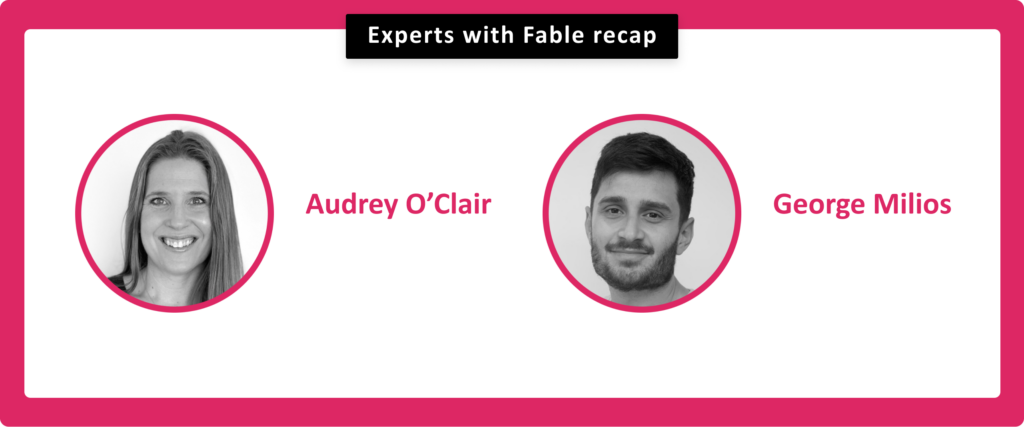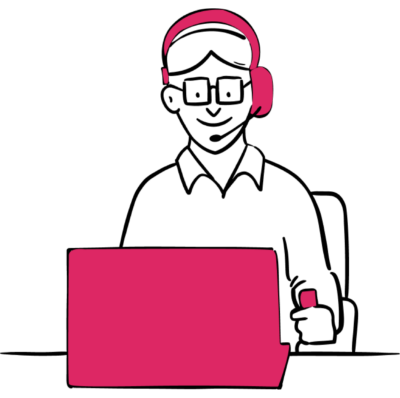
Scaling accessibility knowledge
Experts with Fable recap: How Spotify set up their internal accessibility training
Experts with Fable is an ongoing webinar series where UX designers, researchers, product managers, engineers and accessibility professionals from leading companies discuss their digital accessibility projects, lessons, and strategies. To stay in the loop about future Experts with Fable, follow us on LinkedIn and Twitter, or sign up for our newsletter.
Executing a scalable accessibility program can face many challenges – there may be limited exposure to and understanding of disability across the organization or a small handful of champions trying to create awareness but have limited reach.
Setting up an internal training program helps to not only create empathy and a shared understanding of disability and assistive technology across your organization, but also helps your teams build more accessible product experiences.
In our latest edition of Experts with Fable, Accessibility consultant Devon Persing moderated a discussion with Spotify’s Accessibility and Design Systems Manager Audrey O’Clair, and Education Program Manager George Milios on:
1) Why Spotify recognized the need for accessibility training
2) How they structured their program to create awareness and engagement
3) Wins they experienced along the way
4) Practical ways to incorporate and roll out an accessibility training program
The need for an accessibility program
In 2020, Spotify started seeing grassroots efforts develop around accessibility education. This led to the formation of an Accessibility Guild, a company-wide initiative around accessibility, and the creation of their accessibility team. Their goals were to:
- boost awareness of digital accessibility
- foster inclusive design
- hone accessible development techniques
- Empower their product teams to incorporate accessibility testing with people with disabilities using Fable Engage
Align accessibility training with company values
Every organization is structured differently. It’s important to create a learning foundation based on the existing learning culture within your organization. You know best how things work there. You will understand what your teams crave in terms of education, and what methods and mediums work for them. Spotify emphasized this in their approach, and it worked.
“We were able to align training content with Spotify’s values and expectations by making the content specific to our learners (and their roles).”
– George Milios
By engaging your team in a way that works for them and is practical to their roles, you’ll end up creating more champions and scaling the knowledge across your organization.
Synchronous vs asynchronous training
Spotify moved away from a fully synchronous experience to incorporate asynchronous learning as well through Fable Upskill. Ensuring that accessibility insights were both available and impactful for Spotify’s diverse roles remained a hurdle before revising the program initiatives. They structured a blended learning program of synchronous and asynchronous learning. Adding social experiences, debates, and Q&A practice sessions into synchronous training can be highly effective.
At the same time, structuring their asynchronous learning to include quizzes, short tool tutorials, and assistive technology demos complemented the training.
“If facilitators weren’t available, we wouldn’t be able to run this program. One of the key strategies that we employed was leveraging the flexibility of Fable Upskill course modules, so they’re available on demand at all times. While theory was a thing of a live system in the past, we transformed that component into a fully asynchronous experience with Fable.”
– George Milios
Collaborative team learning enhances engagement
For Spotify, the goal was to foster engagement and facilitate a different understanding of the course material. They acknowledged that learning is always enhanced when there is collaboration and knowledge sharing, so they built out some live internal sessions when rolling out their accessibility training program.
“As accessibility champions we’re very happy and confident with the asynchronous experience that we’re getting from Fable Upskill training courses. We were at the table with Fable co-designing the courses, talking about how we wanted to frame the learning. It was also incredible to have Spotify engineers included in some of the assistive technology (AT) demo videos.
Incorporate a live and interactive element to the learning to support the team as well.”
– Audrey O’Clair
Role-based training
You may have a variety of roles with diverse tasks and responsibilities at your organization. Spotify came up with three distinct tracks:
- user experience
- web development
- mobile development
This approach ensured that participants could choose their track and focus on the activities and learning most relevant to their roles. They provided the space for learners to submit their questions asynchronously. Then, accessibility team leaders answered the questions during the live events. Accessibility team leaders have the role of coaches. At Spotify, learners decide what the content of a live event will be by submitting their questions in advance.
Making a program sustainable
If your organization is global with several teams and departments, it can be a challenge to roll out an accessibility training program. Spotify saw this as an opportunity to make the program more sustainable and robust by researching and understanding how people like to learn new things. One key aspect of this was providing a variety of activities to keep learners engaged.
How to integrate and roll out an accessibility training program
There are several ways to integrate and roll out an accessibility training program.
Create cohorts or learning groups
If there are limited seats, your team will feel more compelled to sign up or at least make it onto the wait list. This can be a strong driver of participation.
Build your courses into learning tracks and include separate, role-based courses within the tracks (Spotify used three). Keep the timeframe to complete the courses between one to two hours each.
Get it in the calendar
Once a participant signs up for the live sessions, send a calendar invite to mark this time commitment within their schedule. Spotify had a total of two and a half hours in live sessions and approximately five hours in self-paced learning.
Create a safe space to make mistakes
Accessibility can be a sensitive topic and one where a lot of people are still discovering the needs and preferences of people with disabilities.
Make it a priority to create a program that is psychologically safe. Spotify created a space for people to make mistakes and ask any type of questions.
Get your team excited
You are passionate about accessibility, user experience, and improving products at your organization and want to ignite this passion in others. Start the learning program with a kick-off event where those who signed up for your learning tracks and courses join for an introduction to accessibility. This is where they’ll get inspired and excited about their ownership.
At Spotify, engineers and the accessibility team leaders were present throughout the three-week cohort meetings. This created a deep connection to them personally and increased awareness, organization-wide, of their “small but mighty” accessibility champions team. Because of this, best practices for accessibility were embraced in an incredible way.
Drive the importance of learners attending every kick-off and sessions in the channels or tools that your team uses to collaborate (Slack, Teams, Zoom chat). Congratulate them any time they are active community members.
Keep learners accountable
Conducting a live session to get people to apply the newly acquired skills adds a bit of urgency. It keeps learners accountable because they know that to participate in the live event, they’ve got to have completed the course modules.
At Spotify, once the self-learning period, in Fable Upskill, wraps up learners hop into the second and final live session. Live sessions that are dedicated for each learning track keep participants engaged and focused.
Conduct practice labs
After holding live sessions and answering learners’ questions, conduct a deep dive into the course topics through practice labs. In the lab, learners go to breakout rooms, into small groups to share thoughts, knowledge and ideas.
Have dedicated exercises for each learning track. Provide an existing web page or mobile screen and ask learners to create a list of accessibility issues on a mock-up. Have your team debate and identify those issues.
Spotify found this part of live sessions the most exciting as learners were eager to present the issues (and solutions) they identified.
Create a ‘study hall’ for learners
Learners learn more when they’re connected and collaborative. Set up a “study hall” to facilitate this.
When taking asynchronous courses, sometimes learners move dedicated study time for accessibility to the bottom of the to-do list throughout the week. But creating a recurring “study hall” meeting calendar invite in their schedule can remind them there is ongoing support.
Spotify set up a study hall for once a week, in a two-hour block.
Accessibility leaders join the video call in case anyone wants needs support. Or, an accountability buddy, if learners want to turn their camera off, turn their mic off, and just work and be held accountable.
Accessibility training with Fable Upskill
When Spotify partnered with Fable to create courses, there was an expectation that only live sessions could consist of Q&A, engaging activities and interactive discussions.
However, with Fable Upskill, asynchronous courses can have interactive elements too. This helps to shift accountability from facilitators to learners.
This blended learning approach meant that Spotify could schedule the live sessions as shorter interactive sessions to accommodate participants across various time zones.
“If we had decided to deliver (all of this accessibility) knowledge in a live segment, we would need many, many hours. We’re very grateful for those modules.”
– George Milios
Watch the full webinar to learn more from Audrey and George
Start usability testing with people with disabilities
Questions about how you can bring people with disabilities into your product design and development cycle to improve user experiences for all?

